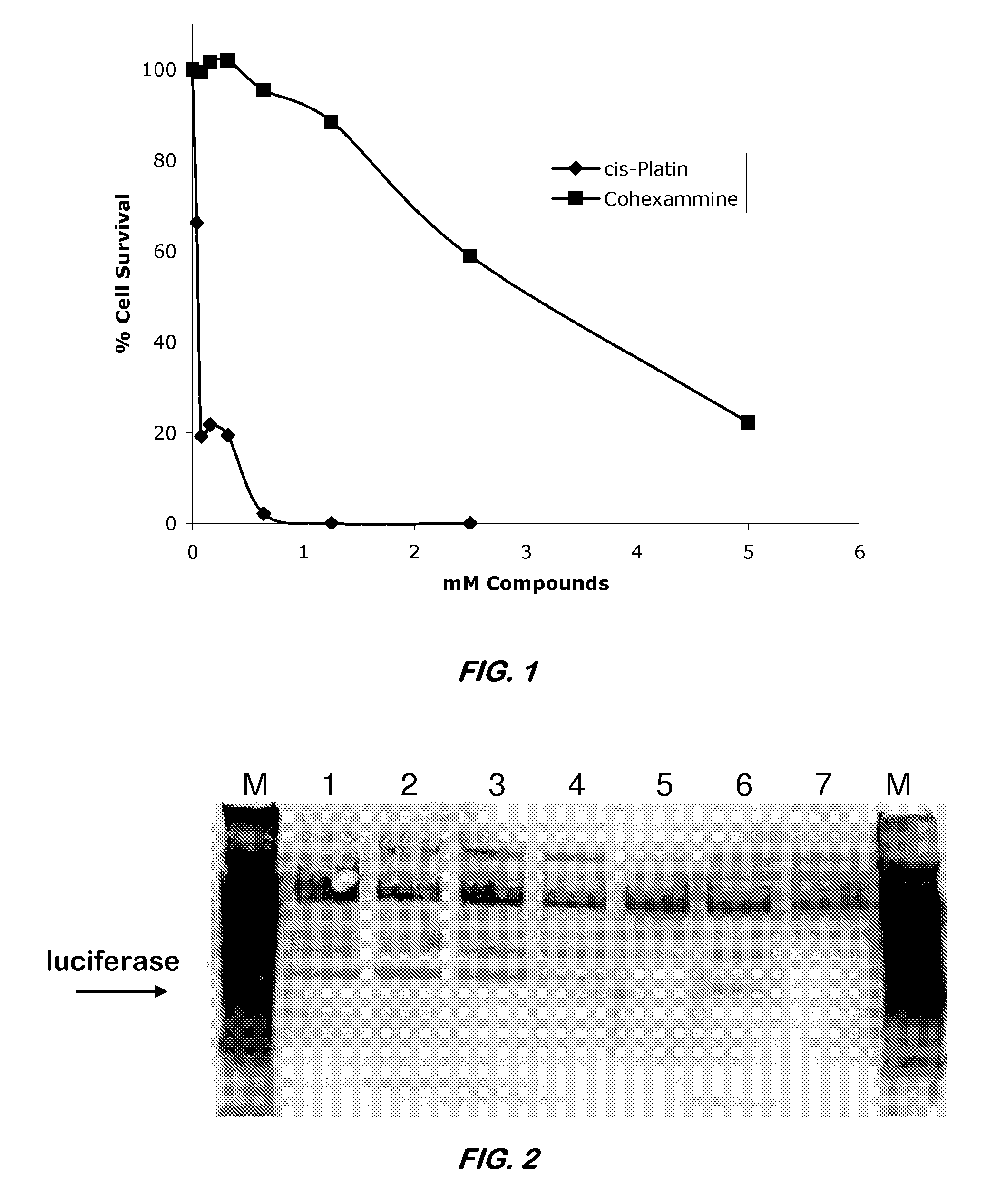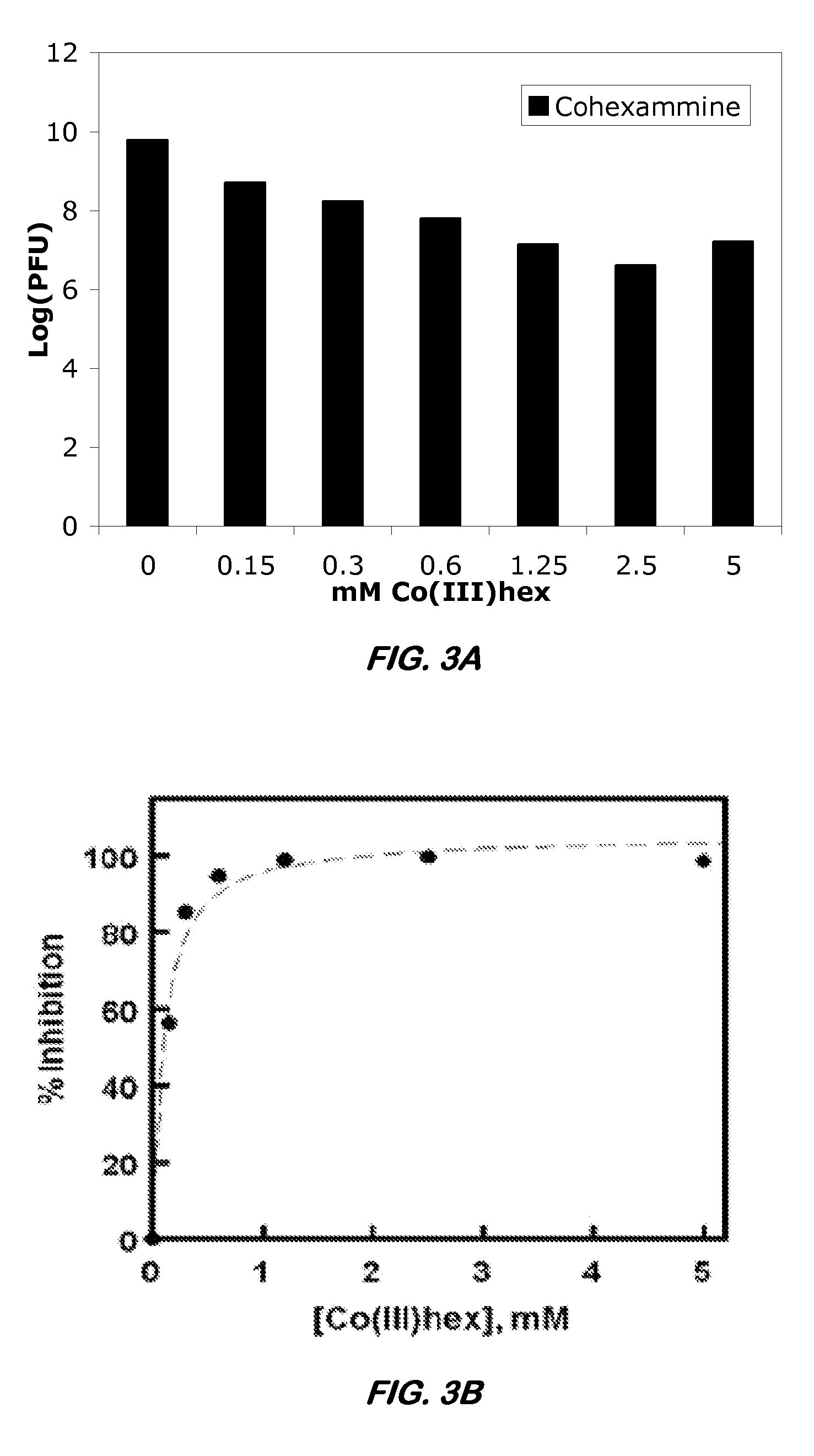Method of using a cobalt-amine based metal complex as an antiviral compound and a method for the preparation of functionalized analogs thereof
a metal complex and cobalt-amine technology, applied in the field of antiviral compound and cobalt-amine based metal complex use, can solve the problems of limiting the treatment options of viral infection, fewer antiviral drugs available, and the degradation of nucleic acids by potent hydrolytic catalysts is much longer than the reaction time of enzymes
- Summary
- Abstract
- Description
- Claims
- Application Information
AI Technical Summary
Benefits of technology
Problems solved by technology
Method used
Image
Examples
example 1
[0036]While Co(NH3)6 is available commercially, the synthesis of its chlorine salt is fairly straight forward and using easily available reagents, for example using air to oxidize Co(II) to Co(III) according to the following formula.
CoCl2+4NH4Cl+20NH3+O2→4[Co(NH3)6]Cl3+2H2O
[0037]The example discussed below is for Co(NH3)6, but one skilled in the art can appreciate that other CoHex complexes of the present invention may be commercially available or synthesized using similar methods. To prepare this Co(NH3)6 example, or more specifically the chlorine salt thereof, 9.6 g of CoCl2.6H2O (0.06 mol) and 6.4 g of NH4Cl (0.12 mol) were added to 40 mL of water in a 250 mL Erlenmeyer flask with a side arm. The mixture was shaken until most of the salts are dissolved. Then, 1 g of fresh activated decolorizing charcoal and 20 mL concentrated ammonia were added. The flask was next connected to the aspirator or vacuum line and air drawn through the mixture until the red solution became yellowish b...
example 2
[0039]The cytotoxicity of Co(NH3)6 (Structure IV) was assessed by monitoring its ability to inhibit proliferation of baby hamster kidney (BHK) cells. BHK cells were cultured as exponentially growing subconfluent monolayers in complete growth medium, particularly Dulbecco's Modified Eagle's Medium (DMEM) supplemented with 1% (v / v) antibiotic / antimycotic agent and 10% (v / v) heat inactivated fetal bovine serum (FBS). Cells were grown in either T25 or T75 flasks (Acton, Mass.) and incubated at 37° C. under 5% CO2 atmosphere. A subculture was performed every 3-4 days.
[0040]The in vitro toxicity of Co(NH3)6 was determined using the CellTiter96® Proliferation Assay (Promega, Madison, Wis.). This quantitative calorimetric assay is based upon the enzymatic conversion of a tetrazolium salt substrate into a blue formazan product with a maximum absorbance at 570 nm. When incubated with this substrate, only viable cells convert the substrate into a blue product while nonviable cells do not. At t...
example 3
[0047]CoHex is capable of preventing translation of a messenger RNA (mRNA) in vitro. The ability Co(NH3)6 to inhibit translation of an mRNA luciferase template was assessed using the Rabbit Reticulocyte Lysate Translation System (Promega) according to the manufacturer's instructions. In the example discussed below, Co(NH3)6 in various concentrations was incubated with the mRNA for 10 minutes before the addition of the mRNA template to the translation lysate. Translated luciferase protein was run on a 10% SDSPAGE gel for 45 min at 130 V and detected by Western blot on a PVDF membrane. Proteins were detected using a streptavidinalkaline phosphatase conjugate and Western Blue substrate according to the instructions in the Transcend Non-Radioactive Translation Detection System (Promega). The results are provided in FIG. 2. In FIG. 2, Lane 1 represents the incubation of 0.01 mM Co(NH3)6. Lane 2 represents the incubation of 0.02 mM Co(NH3)6. Lane 3 represents the incubation of 0.05 mM Co(...
PUM
| Property | Measurement | Unit |
|---|---|---|
| volume | aaaaa | aaaaa |
| volume | aaaaa | aaaaa |
| density | aaaaa | aaaaa |
Abstract
Description
Claims
Application Information
 Login to View More
Login to View More - R&D
- Intellectual Property
- Life Sciences
- Materials
- Tech Scout
- Unparalleled Data Quality
- Higher Quality Content
- 60% Fewer Hallucinations
Browse by: Latest US Patents, China's latest patents, Technical Efficacy Thesaurus, Application Domain, Technology Topic, Popular Technical Reports.
© 2025 PatSnap. All rights reserved.Legal|Privacy policy|Modern Slavery Act Transparency Statement|Sitemap|About US| Contact US: help@patsnap.com



